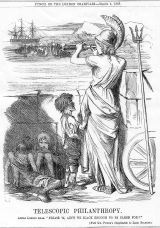
Telescopic Philanthropy
Punch, Volume XLVIII, 4 March 1865, Page 89.

 ublished during a time of upheaval on the question of blacks in both Britain and the United States, "Telescopic Philanthropy" blatantly addresses the question of "foreign" versus "domestic" philanthropy. This cartoon, by Sir John Tenniel, not only carries the words of the "Little London Arab" but also ". . . Mr. Punch's compliments to Lord Stanley," who had spoken on "civilising savages" in Parliament the week before. Punch reports that he had argued against the African squadron and the sea-police as things of the past and that Britain "owed nothing to Africa." "If we wanted to spend a million a year in civilising savages, there was a population within five miles of the House of Commons that stood as much in need of civilisation as the Africans, and had been quite as much neglected." (Punch, March 4, 1865. Pg. 86.) Tenniel's depiction of this idea portrays the obvious difference in proximity of problems for the British. Britannia is presented with her trident and shield at her side, eyeing through a telescope the mass of Africans in the distance, while the "Little London Arab," in plain sight, tugs at her clothes. The symbolism in the children is striking - - their faces are black, likened to Africans and savagery. Their status as Henry Mayhew's idea of urban nomads leads to their being referred to as "Arabs," another dark-skinned race. Mayhew's interpretation, that there are "two distinct and broadly marked races. . . the nomadic and the civilized tribes," alludes to a later statement he makes, which raises questions relating to these children: "not only are all races divisible into wanderers and settlers, but. . . each civilized or settled tribe has generally some wandering horde intermingled with, and in a measure preying upon, it."(1)
ublished during a time of upheaval on the question of blacks in both Britain and the United States, "Telescopic Philanthropy" blatantly addresses the question of "foreign" versus "domestic" philanthropy. This cartoon, by Sir John Tenniel, not only carries the words of the "Little London Arab" but also ". . . Mr. Punch's compliments to Lord Stanley," who had spoken on "civilising savages" in Parliament the week before. Punch reports that he had argued against the African squadron and the sea-police as things of the past and that Britain "owed nothing to Africa." "If we wanted to spend a million a year in civilising savages, there was a population within five miles of the House of Commons that stood as much in need of civilisation as the Africans, and had been quite as much neglected." (Punch, March 4, 1865. Pg. 86.) Tenniel's depiction of this idea portrays the obvious difference in proximity of problems for the British. Britannia is presented with her trident and shield at her side, eyeing through a telescope the mass of Africans in the distance, while the "Little London Arab," in plain sight, tugs at her clothes. The symbolism in the children is striking - - their faces are black, likened to Africans and savagery. Their status as Henry Mayhew's idea of urban nomads leads to their being referred to as "Arabs," another dark-skinned race. Mayhew's interpretation, that there are "two distinct and broadly marked races. . . the nomadic and the civilized tribes," alludes to a later statement he makes, which raises questions relating to these children: "not only are all races divisible into wanderers and settlers, but. . . each civilized or settled tribe has generally some wandering horde intermingled with, and in a measure preying upon, it."(1)
These children are unmistakably British. However, is it they who are preying upon British society, in Mayhew's words, or is British society, by ignoring their needs, preying on them? Even in the shadows, one child's hair is drawn lightly, while, more importantly, their facial angles are undeniably those of an evolved race, nearing the ninety degrees seen as Classical perfection. The shadows are a planned part of Tenniel's interpretation; in fact, it seems he was so intent on drawing the shadow on the children that he made a slight artist's error, either by mistake or possibly on purpose - the shadow on the children and that given by Britannia's trident are obviously going in two different directions. Instead of paying attention and aiding her own, Britannia is peering into the distance at the mass of Africans being spoken to by a single English missionary. The Africans are an indistinguishable mob of savagery in their natural surroundings of jungles and mountains, while the children seem to be living unnoticed in the darkness of Britannia's shadow, singular and alone, clothed in rags and not "black enough to be cared for."
The details of this cartoon prove specific feelings at a particular period in time. At this point the British had already abolished slavery in the empire and were extremely aware of the American Civil War and its question of slavery. In March of 1865, it was questioned in Parliament as to whether or not blacks should be aided to the extent that they were. Seven months later, in October 1865, the revolt in Jamaica would break out and effectively alter philanthropic views towards blacks. By 1867 the second Reform Bill had been passed and the concentration had further shifted from the civilizing of foreign savages to caring for one's own "savage" population. "Telescopic Philanthropy" was turning around.
1. Henry Mayhew, London Labour and the London Poor: A Cyclopaedia of the Conditions and Earnings of Those that WILL Work, Those that CANNOT Work, and those that WILL NOT Work, Vol I (London: Frank Cass & Co., Ltd., 1967), Page 1.
[Victorian initial "P" by Harlan Wallach ©copyright 1994.]